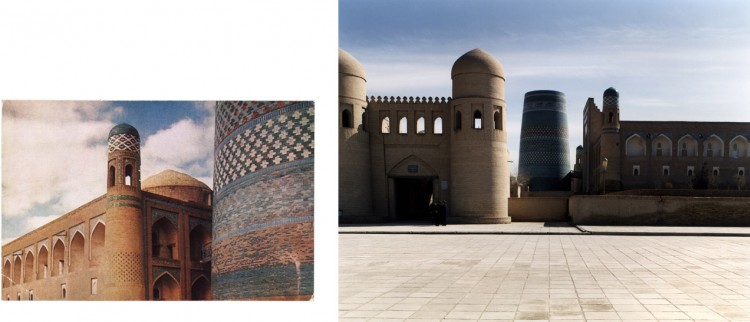
I was ten years old when I found my first photograph of Uzbekistan in a small English village flea market just outside Manchester. It was a postcard showing schoolgirls in uniform giving a gymnastic performance in a schoolyard. The writing on the card was in Russian, French and Arabic. The postcard was interesting because nobody knew where it was from and yet the scene looked very familiar. The photograph dated back to the beginning of the twentieth century and it could easily have been taken in the courtyard in which I was standing at the time. Unable to read the Cyrillic print on the postcard, my teachers could only suggest that the photograph had been taken somewhere in Russia, though they could not explain why the handwriting on the back was in Arabic. Ten years later, while rummaging through a pile of old schoolbooks, the same postcard fell out from between the pages. I soon discovered that the Cyrillic text printed next to the photograph read: SAMARKAND - Girls Grammar School.
This postcard is the first in a collection of over a thousand postcards depicting scenery and architecture in Uzbekistan. I have picked them up over the past eight years in antique shops and flea markets throughout Europe and Central Asia. There are very few postcards of Uzbekistan in circulation in Western Europe. Postcards are usually sent or brought back by people who visit the places depicted on them, yet Uzbekistan has always been a difficult place for Western Europeans to go. Most people have never heard of the country. I initially looked out for these postcards because of the difficulty in finding them and my interest in Uzbekistan developed through this accumulation of images. Each new postcard added another element to help me piece together an understanding of the country's complex history, geography and demography. Soon, I was able to decipher Cyrillic script and I could locate even the smallest Uzbek town or monument on the map. I was particularly interested in architecture and scenery because they are a witness of time. A group of people in traditional dress disappears after their image is taken whereas a building or a river remains. I hoped that one day I might find the places in these postcards, so as to discover this country that was gradually becoming part of my own history.
Otkritki, which means postcard in Russian, is the product of three trips to Uzbekistan over the past three years. Approximately half of the places in the postcards are well known monuments, the other half are forgotten but to a few. It is from this half, where names have changed, statues have fallen and lakes have disappeared, that I learn the most. The disparity between the image on the postcard and the photograph I take tells a story in its own right. Equally, it is the people I meet and the stories they tell to help me find these places that make this project, beginning twenty-one years ago in a schoolyard, worthwhile.

Kalta Minor minaret and Mohammed Amin Khan madressa, Khiva 1970